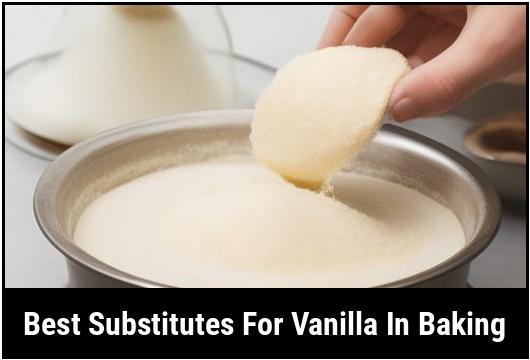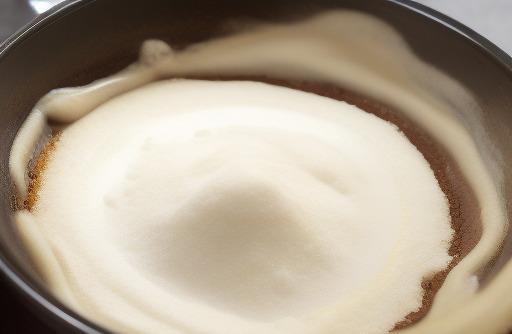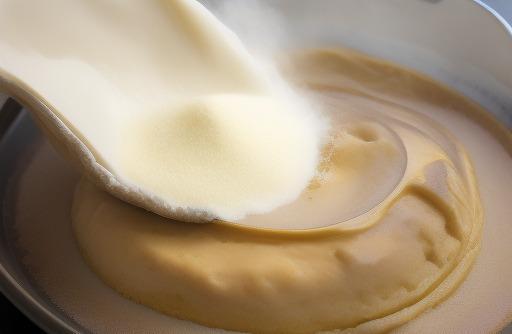Best Substitutes For Vanilla In Baking

Vanilla is a popular flavoring ingredient in baking, known for its sweet and aromatic taste. It adds depth and richness to various desserts, such as cakes, cookies, and puddings. However, there may be times when you find yourself without vanilla extract or need to avoid it due to allergies or personal preferences. In such situations, having knowledge of the best substitutes for vanilla can save your baking projects.
Key Takeaways
- Vanilla extract can be substituted with a variety of ingredients, such as vanilla bean, vanilla bean paste, vanilla powder, almond extract, maple syrup, and others.
- Different substitutes may offer slightly different flavors and intensities, so it’s important to choose the one that suits your recipe and personal taste.
- Substitutes for vanilla can be used in the same quantities as vanilla extract, but it is advisable to begin with a smaller amount and adjust according to taste.
Why You Need A Substitute For Vanilla In Baking
There are several reasons why you may need to find a substitute for vanilla in baking. Perhaps you ran out of vanilla extract and don’t have time to restock, or maybe you have dietary restrictions or allergies that prevent you from using vanilla. Additionally, some people may simply not enjoy the taste of vanilla and prefer alternatives. Whatever the reason, having a good vanilla substitute on hand can help you continue baking delicious treats without compromising flavor.
Types Of Substitutes For Vanilla In Baking

When it comes to finding a substitute for vanilla in baking, there are a few options available. These substitutes can add their unique flavors and aromas to the recipe, enhancing the overall taste profile. Here are some common substitutes:
-
Vanilla Bean: The closest alternative to vanilla extract is a vanilla bean. Vanilla beans are the actual seed pods of vanilla orchids and provide a concentrated vanilla flavor. To substitute one teaspoon of vanilla extract, use the seeds scraped from half of a vanilla bean. Simply split the vanilla bean lengthwise, scrape out the seeds, and add them directly to your recipe.
-
Vanilla Bean Paste: Vanilla bean paste is another excellent substitute for vanilla extract. It is a blend of vanilla bean seeds, vanilla extract, and a thickening agent. The paste adds the concentrated flavor of vanilla beans without the need for extracting the seeds. Use the same amount of vanilla bean paste as you would for vanilla extract in your recipe.
-
Vanilla Powder: Vanilla powder is made from ground vanilla beans and offers a convenient way to substitute for vanilla extract. It has a concentrated flavor and can be used in the same quantities as vanilla extract. Add one teaspoon of vanilla powder per teaspoon of vanilla extract required in the recipe.
-
Almond Extract: Almond extract is a potent and fragrant alternative that adds a nutty flavor to your baked goods. While it does not replicate the exact taste of vanilla, it can provide a rich and aromatic profile. Substitute vanilla extract with half the amount of almond extract in your recipe. For example, if a recipe calls for one teaspoon of vanilla extract, use half a teaspoon of almond extract instead.
-
Maple Syrup: If you’re looking for a natural and sweet substitute for vanilla extract, maple syrup can be a great alternative. It adds a subtle maple flavor to your baked goods, enhancing their taste while providing a touch of sweetness. Substitute vanilla extract with an equal amount of maple syrup in your recipe. However, be aware that maple syrup can darken the color of your baked goods.
-
Rum: Rum can be used as a flavorful substitute for vanilla extract in certain baked goods, particularly in recipes that can benefit from its distinctive taste. Use the same amount of rum as you would for vanilla extract in your recipe. Keep in mind that rum may alter the flavor profile, so it is best suited for recipes where its taste complements the other ingredients.
Best Substitutes For Vanilla In Baking

While there are several options available, some substitutes work exceptionally well in specific types of baked goods. Here are the best substitutes for vanilla in baking, depending on the dessert you’re preparing:
-
Cakes: Vanilla bean or vanilla bean paste are ideal substitutes for vanilla extract in cakes. They add a rich and intense vanilla flavor, enhancing the taste of the cake. Alternatively, almond extract can be used for a nuttier profile.
-
Cookies: Almond extract is a great substitute for vanilla extract in cookies as it adds a unique nutty undertone. If you prefer a distinct vanilla flavor, vanilla bean paste or vanilla powder can also be used.
-
Muffins: In muffin recipes, you can use either vanilla bean or almond extract as a substitute for vanilla extract. Both options provide delightful flavors that complement the muffin’s texture.
-
Puddings: Vanilla powder is an excellent substitute for vanilla extract in puddings. Its concentrated flavor ensures a rich and aromatic taste, elevating the dessert.
-
Frostings: For frosting recipes, vanilla bean paste is an ideal substitute as it enhances the flavor while maintaining the desired consistency. You can also use almond extract or rum, depending on the desired taste.
Choosing The Right Substitute For Vanilla In Baking

Choosing the right substitute for vanilla in baking is crucial to ensure that it complements your recipe and personal preferences. Here are a few factors to consider when selecting a substitute:
-
Flavor Profile: Some substitutes, like vanilla bean and vanilla bean paste, provide a similar flavor to vanilla extract. However, others like almond extract or rum offer distinct taste profiles. Consider how the substitute flavor will complement or enhance your recipe.
-
Intensity: Vanilla extracts have varying intensities, and the same applies to their substitutes. For a weaker vanilla flavor, use less of the substitute, and adjust it to taste. On the other hand, if you desire a stronger vanilla presence, you may need to add more of the substitute.
-
Recipe Considerations: The type of baked goods and their specific requirements should also influence your choice of substitute. For example, vanilla bean paste or vanilla powder may work better in recipes where extract might compromise the texture or consistency.
-
Personal Preference: Ultimately, your personal taste preference plays a role in selecting the best substitute. Experiment with different substitutes to find the one that best suits your liking and the particular recipe.
Remember that substituting vanilla extract with another ingredient may result in a slightly different taste. Embrace the opportunity to explore new flavors and adapt your recipe to create a unique twist on a classic treat.
Pro Tip: When using substitutes for vanilla extract, always start with a smaller amount and adjust to taste. Keep in mind that some substitutes may have a stronger flavor, so a little goes a long way.
Cooking With Substitutes For Vanilla In Baking

Incorporating substitutes for vanilla extract in your baking requires appropriate measurements to maintain the desired flavor profile. Here are some essential tips to keep in mind:
-
Conversion Ratio: When substituting vanilla extract, use the same amount of the substitute as the quantity of extract specified in the recipe. For example, if a recipe calls for one teaspoon of vanilla extract, replace it with one teaspoon of the chosen substitute.
-
Adjusting Taste: Since each substitute offers a distinct flavor profile, it’s important to taste the batter or dough before baking and adjust the amount of substitute as needed. Add more if you desire a stronger flavor or reduce it if you’re happy with a milder taste.
-
Combining Substitutes: In some recipes, you might consider using a combination of substitutes to achieve the desired flavor profile. For example, mixing vanilla bean paste with almond extract can create a nuanced taste.
-
Consider Texture: Depending on the recipe, certain substitutes may affect the texture or consistency. Keep in mind that substitutes such as maple syrup or rum might increase the moisture content, which could impact baking times or result in a denser texture.
Recipes Using Substitutes For Vanilla In Baking

Now that you have a variety of substitutes to choose from, here are a few delicious recipes where you can incorporate them:
1. Classic Vanilla Cupcakes (Using Vanilla Bean)
Ingredients:
- 2 ¼ cups all-purpose flour
- 1 ½ cups granulated sugar
- 3 ½ teaspoons baking powder
- 1 teaspoon salt
- 1 ¼ cups milk
- 1 vanilla bean (seeds scraped)
- ½ cup unsalted butter, softened
- 3 large eggs
Instructions:
- Preheat the oven to 350°F (175°C) and line a cupcake pan with liners.
- In a mixing bowl, combine flour, sugar, baking powder, and salt.
- Add milk, vanilla bean seeds, and softened butter to the dry ingredients. Mix until well combined.
- Beat in the eggs one at a time, ensuring they are fully incorporated.
- Divide the batter evenly among the cupcake liners, filling each about two-thirds full.
- Bake for 18-20 minutes or until a toothpick inserted into the center of a cupcake comes out clean.
- Let the cupcakes cool completely before frosting with your desired substitute.
2. Almond Thumbprint Cookies (Using Almond Extract)
Ingredients:
- 1 cup unsalted butter, softened
- ¾ cup granulated sugar
- 2 teaspoons almond extract
- 2 cups all-purpose flour
- ½ cup raspberry jam
Instructions:
- Preheat the oven to 350°F (175°C) and line a baking sheet with parchment paper.
- In a mixing bowl, cream together the softened butter, granulated sugar, and almond extract until light and fluffy.
- Gradually add the flour to the creamed mixture, mixing until well combined.
- Shape the dough into 1-inch balls and place them on the prepared baking sheet.
- Make an indentation in the center of each cookie using your thumb or the back of a spoon.
- Fill each indentation with raspberry jam.
- Bake for 10-12 minutes or until the cookies are lightly golden around the edges.
- Allow the cookies to cool before serving.
3. Vanilla Bean Panna Cotta (Using Vanilla Bean Paste)
Ingredients:
- 2 cups heavy cream
- ½ cup granulated sugar
- 2 teaspoons vanilla bean paste
- 2 teaspoons powdered gelatin
- ¼ cup cold water
Instructions:
- In a saucepan, heat the heavy cream and granulated sugar over medium heat until just simmering. Remove from the heat.
- Stir in the vanilla bean paste until fully incorporated.
- In a separate bowl, sprinkle the powdered gelatin over the cold water and let it sit for 5 minutes until it becomes spongy.
- Place the bowl containing the gelatin mixture in a larger bowl filled with hot water, stirring until the gelatin dissolves completely.
- Pour the gelatin mixture into the warm cream mixture, stirring well.
- Divide the mixture into serving glasses or ramekins and refrigerate for at least 4 hours or until set.
- Serve chilled, garnished with fresh berries or a drizzle of chocolate sauce.
Storage And Shelf Life Of Substitutes

Knowing how to store substitutes for vanilla extract properly will help maintain their freshness and quality. Here are some guidelines:
-
Vanilla Bean: Store vanilla beans in an airtight container at room temperature, away from direct sunlight and heat. They will retain their flavor for up to a year.
-
Vanilla Bean Paste: Vanilla bean paste should also be stored in an airtight container at room temperature. It can last for several years if properly sealed.
-
Vanilla Powder: Keep vanilla powder in an airtight container in a cool and dry place. It has a shelf life of approximately 2-3 years.
-
Almond Extract: Store almond extract in a cool, dark place, away from heat and light. It will remain fresh for about 3-4 years.
-
Maple Syrup: Properly sealed maple syrup can be stored in the refrigerator for up to one year. Ensure that it is in a glass or plastic container with a tight lid to prevent absorption of other flavors.
-
Rum: Store rum in a cool, dark place, away from direct sunlight. It can be kept for an extended period, often years, without any significant change in flavor.
Conclusion
Having a reliable substitute for vanilla in baking allows you to continue creating delicious treats even when you don’t have vanilla extract or cannot use it. Whether you opt for a vanilla bean, vanilla bean paste, almond extract, or any other substitute, each offers its unique flavors to enhance your baked goods. Remember to adjust the quantity of the substitute to taste, experiment with combinations, and consider the specific requirements of your recipe. With the right substitute, you can still enjoy the delightful taste of vanilla in your favorite baked treats.
FAQS
What Are Some Good Substitutes For Vanilla In Baking?
Some great substitutions for vanilla in baking include almond extract, maple syrup, orange or lemon zest, and even brewed coffee. These substitutes offer similar flavors and will still add a delicious and distinct taste to your baked goods.
Can I Use Vanilla Powder As A Substitute For Vanilla Extract?
Yes, you can use vanilla powder as a substitute for vanilla extract in baking, but keep in mind that the powder is much more concentrated than the extract. You’ll only need to use a small amount of powder to achieve the same level of flavor as you would with vanilla extract.
What Can I Use Instead Of Vanilla In Recipes For People With Allergies?
If you or someone you’re baking for has a vanilla allergy, you can use other flavorings like cinnamon, nutmeg, or cardamom. You could also try using extracts like almond, peppermint, or coconut.
Can I Simply Use More Sugar As A Substitute For Vanilla In Recipes?
While adding more sugar can help with flavoring, it won’t provide the same distinct taste that vanilla extract does. It’s best to use one of the suggested substitutes in place of vanilla to achieve the desired taste.
Are There Health Benefits To Using Vanilla Substitutes In Baking?
Some of the substitutes for vanilla extract, like almond extract, offer health benefits due to their high antioxidant content. Maple syrup is also a natural sweetener that contains minerals like zinc and manganese. However, it’s important to remember that these substitutes are still sweeteners and should be used in moderation.
Sources
About the Author Jenny
I'm Jenny, a housewife with an unwavering passion for food. My culinary journey began with my grandmother's kitchen, and it's now a full-fledged food blog. I've turned my love for cooking into a creative outlet, sharing recipes and stories with a global community of fellow food enthusiasts. It's proof that being a housewife can also mean pursuing your passions and savoring life's delectable moments.
